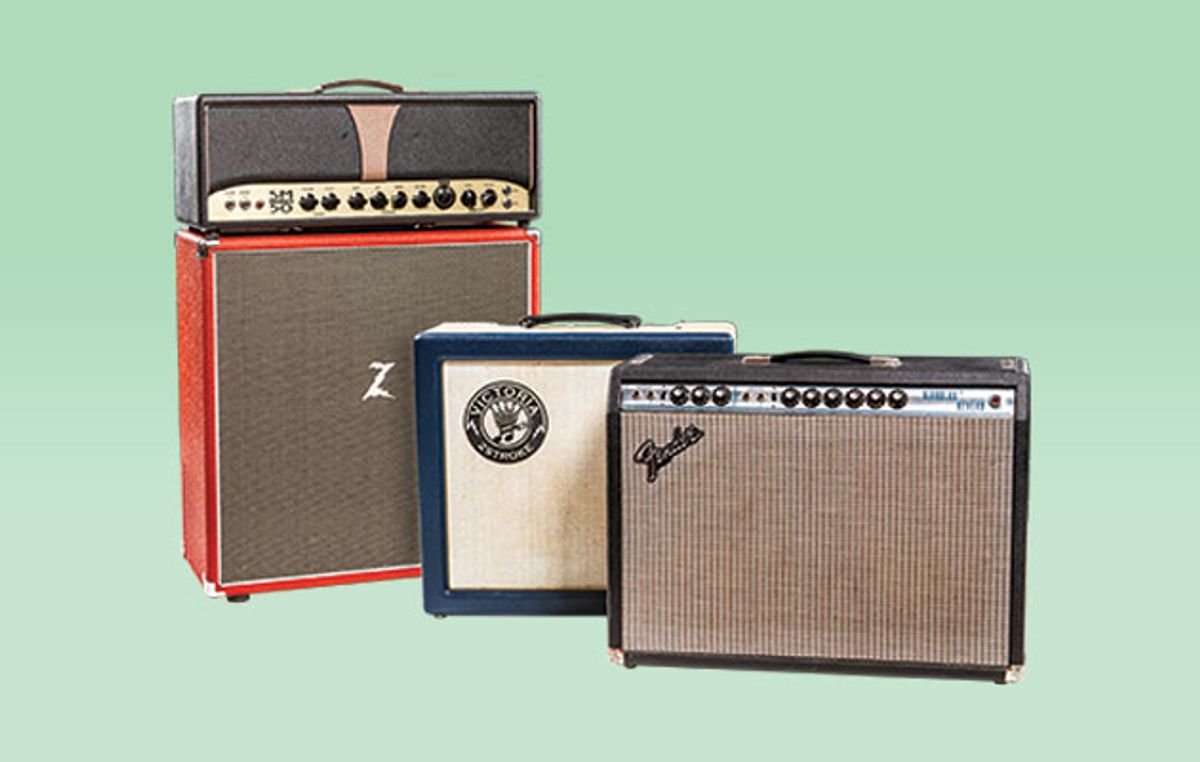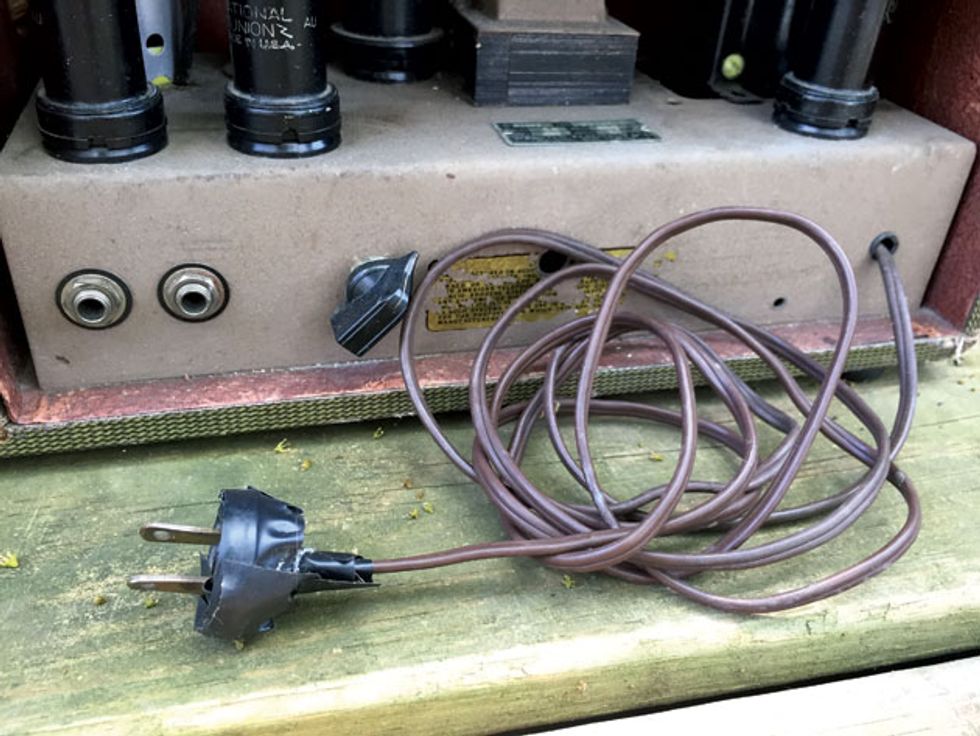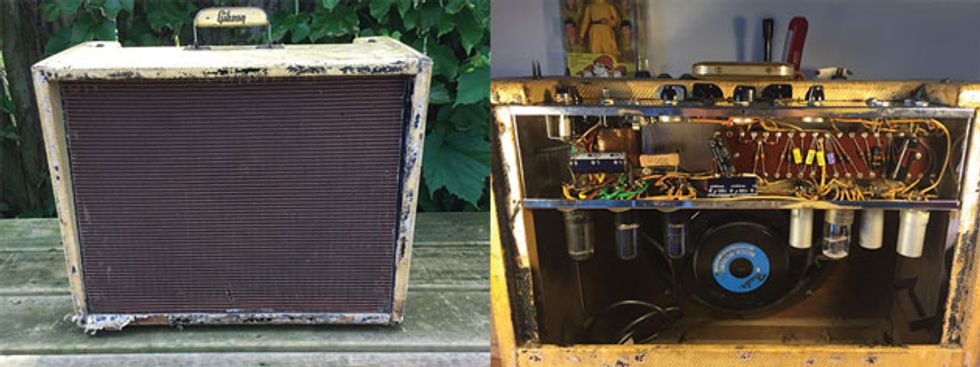
Tim Schroeder—amp builder for Jeff Tweedy and Nels Cline—offers seven tips for avoiding the post-purchase blues.
So, you “need” a new amp, huh? Maybe you’re looking for a certain sound, or your old amp is no longer reliable enough for gigging. Perhaps that mammoth stack from your high-school years—y’know, the one with the lightning bolt and pot leaf stenciled on the grille cloth?—doesn’t quite fit with your current décor. Or maybe your income has changed and you finally have enough scratch to purchase your dream amp.
There are many reasons to search for a new amp, but the most common is probably that we’re simply looking for that “perfect” setup that’ll finally allow us to convey the sound in our heads to the rest of the world. After all, your amp’s speaker is literally the last signal-chain element shaping the sound that hits waiting eardrums.
As a repair tech, amp builder, engineer, luthier, and business owner for the last 25 years, I’ve had the pleasure of helping countless guitarists find their sound. And for those who are searching for new amplification fulfillment, these are the concepts and questions I pose during our first get-to-know-you session. For the purposes of this article, I’ll limit myself to used amps and common practical concerns.
Take a Self-Inventory
Among the first questions to ask yourself when you get that hankering for a hunk o’ amp is, “What needs is this amp going to fulfill?” If the eventual purchase is going to be your main (or only) amp, your parameters likely need to be a lot more strict and wide ranging than if the amp is a living-room novelty, a one-trick studio pony, or something intended to complement an existing rig (e.g., to run in tandem with another amp, to switch in and out for clean or dirty sounds, to create a stereo spread, or to use as an effects satellite).
If you’re a professional musician who earns a living through gigging, then dependability should be a primary concern—doubly so if you tour on routes where a good tech may not be available in an emergency. For many players the reliability issue is compounded by the fact that a tour’s space and budget constraints don’t allow for backup rigs.
On the other hand, your outlook will be vastly different if you’re a collector. Some favor specific brands and aim to have an original specimen of each model ever produced by the company, while others focus on models that played an important part in musical history (e.g., the Marshall Super Lead, Ampeg B-15, tweed Fender Bassman, or Vox AC30). For either type, if the desired amp rarely comes up for sale, the trouble areas we’ll discuss later may not even be a deal breaker because you may simply be looking for a specimen you can restore to its former glory.
Safety (and Functionality) First
For most players, the next step after narrowing down what you need from the amp is establishing a budget. This may seem like a simple question: “I have $800 to spend. I’ll get an $800 dollar amp.” But I regularly see clients fall short of their goals with this line of thinking. Regardless, here are a few basic problem areas to watch for—and it goes without saying that these issues become exponentially more important the older your target amp is.
amp going to fulfill?”
Ensure the amp is safe to operate. If the amp you’re looking at is older (e.g., from the 1930s–1960s), does it have basic modern safety features necessary to keep you out of harm’s way? These include having a three-prong grounded power cord, having all the capacitors with voltage present properly covered, and having the correct fuses. These safety upgrades may not be particularly costly to fix—especially in the case of fuses and a power cord, the latter of which should only cost $40–$50 to install—but you can’t put a price on your own physical well-being.
Assess current operating state. Has the amp been regularly maintained and is it functioning properly now? Are the tubes in good working order? Has it recently had a basic cleanup and tube-bias check? Does it have healthy electrolytic capacitors? To many players, these questions may elicit nervous laughter and/or a blank stare, but don’t worry. If you don’t have technical expertise or service records to rely on, you can let your ears be your guide: With the amp on and in play mode—but no instrument plugged in—listen carefully. Do you hear crackling, popping, or excessive hum? Next (still with nothing plugged in), turn one control at a time from minimum to maximum. (Before you do this, you should be aware that the amp may suddenly feed back—loudly. So be careful!) Other than feedback or a squeal—symptoms that indicates the amp is going to need professional attention—you should also listen for the lesser crime of scratchiness. This also indicates the amp needs (or will eventually need) help, but it may be tolerable for quite some time if the sound only occurs when you turn the knob. (In some instances, the scratchiness may simply be due to not being played for years, in which case it may go away after turning the knobs back and forth a bunch of times to sort of scrape off the dusty inner workings.)
Now plug an instrument in and play a sustained cord without any effects or distortion. Listen to the attack and decay of the notes, paying close attention to any fizzle or volume jumps or dips. Also, look at the power tubes while the amp is powered up. Don’t worry if the tubes glow a little differently from one another. What you’re looking for is whether a tube’s plate (the large, middle part of the tube) is glowing bright red like an old-school cigarette lighter from a car. If you experience any of these adverse symptoms, you could easily spend an extra $200 to $400 to get the amp up to snuff. Also, because so many players buy online (and therefore don’t have the chance to test-drive an amp or have it checked by a tech), it’s important to keep in mind that eBay or Craigslist sellers may not know the state of these items—or may misrepresent their state out of either ignorance or greed. Because of this, if your budget is fairly inflexible, consider browsing amps priced a bit lower than your actual cash reserves on hand—especially if there are no built-in safeguards to help you gauge the current owner’s trustworthiness and track history, such as eBay’s seller ratings and feedback system. That way you’ll have money to rehabilitate your amp if necessary. And trust me, a $500 amp that works properly is much more enjoyable than an $800 amp that pops, buzzes, and causes your lip to get zapped every time you sing into a microphone.
If you find an old amp like this cool-looking 1930s model that doesn’t have a grounded, three-prong power cable, you should count on spending an extra $50 to have one added in order to avoid risk of electric shock during use.
Photo by Tim Schroeder
Assess real-world performance. If you’re considering buying a combo or speaker cab and have the chance to play it in person, play all the notes across your guitar’s entire fretboard at varying volumes to check for voice-coil rub in the speaker or rattling in the cabinet or chassis. If you intend to primarily play the amp in a loud band, this extraneous noise may or may not be a big concern. But if you’ll be playing in a quiet space or using the amp for recording, then even a small amount might be maddening. This problem is especially important to watch for in vintage amps where glue may have dried and cracked or simply lost its ability to bond surfaces together. Other rattle culprits include worn-out, damaged, or loose baffles, tubes, or screws. (I’ve even seen a pilot light clatter to the point that it would be unusable in a recording session!) As with electrical issues, these types of problems take time and money to resolve.
Although the exterior of this early-’60s Gibson GA-30T has seen better days, what makes it a real player’s amp is what’s inside. As the shot of the amp’s guts attests, it’s in pristine condition due to either consistent upkeep or painstaking restoration—and that means it should be reliable and sound great.
Research Brands
To some it may seem like researching available brands is either unnecessary (because you already know what you want) or a no-brainer first step. But given the previously mentioned unforeseen costs that often arise when buying a complex mechanical and electrical device like a guitar amp, you may quickly find that the coveted blackface Fender or vintage-plexi tones you crave simply aren’t within your budget, in which case you’ll want to find out if there are other, more affordable means of attaining similar sounds. These “sleeper” amps can be high-quality, factory-made models of yesteryear that never caught on like the household brands guitarists discuss in revered tones. (For example, vintage ’60s Ampeg guitar combos, as well as the 1990s and early 2000s reissues, can yield Fender-like tones for significantly less money than original blackface or silverface amps, or even the modern reissues.) Sleepers can also be more recent boutique brands that are still on their way up or that never quite made a name for themselves. In either case, the tones are often on par with well-known brands, but the resale value is much more reasonable—although the easy exchange of information on the internet has begun to cause the price of many sleepers to creep up. Great deals are still out there, though.
Speaking of online forums and experienced player friends, although they are perhaps the easiest and fastest source of amp information, in my opinion nothing beats an experienced tech—particularly if your budget-driven expectation revisions have got you pondering lesser-known brands or models. A veteran tech has likely seen all sorts of failures on all types of amps, and they should have first-hand knowledge of which amps have, say, circuit-board-mounted input jacks that fail regularly and cost $100 in labor to replace a 97-cent part.
Buy What Fits Your Needs
Whether you’re a beginner or a seasoned pro, it’s easy to fall prey to the shiny things in life. Music is full of emotion and makes us feel good, so it’s no surprise that the instruments used to make it also instill us with a lot of emotion. But while purchasing a new instrument is exciting and can inspire you in ways that perhaps your old gear hasn’t, it’s crucial to resist the impulse to immediately click Buy Now or plop your hard-earned cash on the counter before stepping back to look at the big picture. It might be tempting to spring for the screaming deal on that state-of-the-art head you’ve always lusted after, but if you don’t truly need three channels, MIDI, a buffered effects loops, onboard effects, and a milk-steaming attachment for cappuccino, then spend the money on a higher quality single- or dual-channel amp. There are players who need those options, but don’t let the amazingness of a deal you stumble onto divert you from being conscious of and realistic with your needs. If you mostly play in your basement, a 100-watt Marshall cranked to its sweet spot and then squashed by an attenuator will not sound like Hendrix at the Fillmore. At the other end of the spectrum, if you’re a spring-reverb junky, are you really going to be happy with that two-knob combo that’s priced to move?
Seek out Reputable Dealers
The number of people with used amps to sell is obviously vastly larger than the number of dealers with significant stores of cool old amps. And the well-stocked shops that do exist tend to be concentrated in larger cities, which means you may have to expend considerable time and expense for the trip. Nevertheless, the reasons to make your purchase through a reputable dealer are many. They usually have several makes and models to choose from, each with its own tonal character, features, and price points. They often know the previous owner, which may mean they know the amp’s history—not just practical details about past repairs and mods, but historical elements that make the purchase even more meaningful. There’s also a good chance the shop cleaned, maintained, or repaired the piece, and this can only increase the odds of ending up with an amp that’s hassle free and sounds as expected. The best dealers have people who can quickly help you narrow your search after a brief discussion, and they aim to develop a good relationship with you and make sure you’re happy with your purchase. For these shops, it’s a point of pride when clients come back weeks, months, or years later talking about how great their rig sounds because of an associate’s help.
Even better, good dealers often have a period during which you can take the instrument home to see if it’s a good fit (e.g., with the rest of your rig) or to a third-party tech who can advise you on the amp’s condition. Think of it like a used-car purchase: A pre-owned car may be a big investment, but many used amps also fetch serious sums—and they’re also complex devices with a lot more going on than the average guitarist understands. A wise used-car buyer wouldn’t buy without having a mechanic give the vehicle a quick once over, and the same goes for amps.
The sleeper products we were talking about earlier are yet another reason to consult with a good used dealer. Sometimes a great sleeper amp will sit on the floor for a very long time simply because customers come in to look for a specific product instead of letting the dealer know what sorts of sounds they’re looking for.
Go Forth and Amplify
This is only a brief overview designed to make you aware of questions that are often overlooked when eager guitarists have “need new amp” playing incessantly in their heads. So keep these in mind during your search, but also remember to enjoy the search and take something away with you from every experience—whether it’s a mental note on what sorts of power tubes tend to yield the dynamic response you prefer, what sorts of features you won’t use (and therefore shouldn’t expend money on), or which obscure brands and models to keep your eyes peeled for. I’ve deliberately steered clear from tone and other subjective topics here because, after all, your sound should be your sound, and should set you apart from the pack. Happy hunting!



